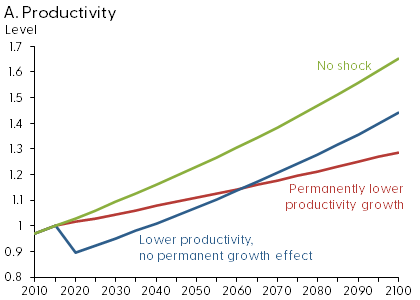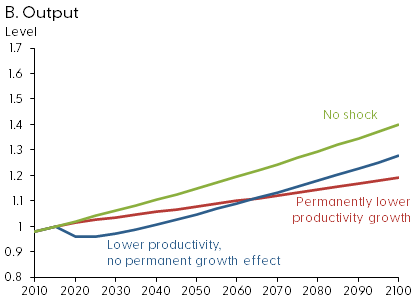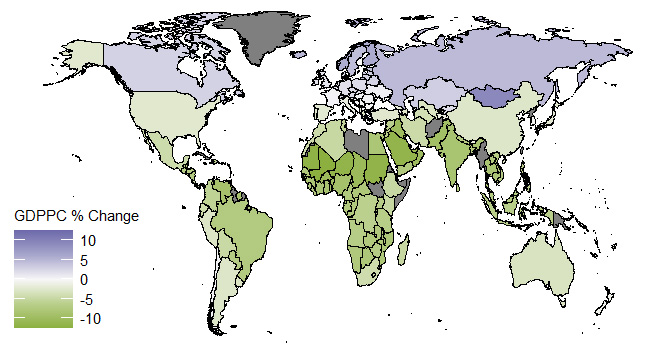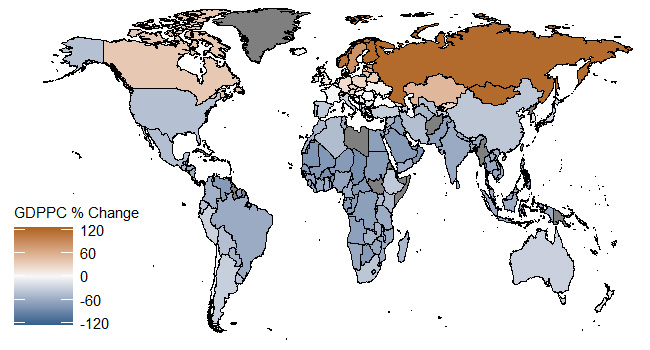How might rising temperatures around the world affect the growth rate of GDP per person? Examining data across countries over the past half-century shows that a change in temperature affects GDP growth, but only temporarily. Combining estimates from past data with a simple growth model can help project the impacts of future higher temperatures on GDP per person by country. These projections suggest that total global losses in output per person could be substantial, though smaller than if a given change in temperature had a permanent effect on GDP growth.
Economic growth is an important variable underlying economic and monetary policy analyses. Many factors affect economic growth, including technological innovation and changes in the labor force. Environmental conditions can also impact economic growth through their effects on productivity. This Economic Letter explores the impacts of predicted changes in temperature on productivity and economic growth. Using a large data set covering 155 countries, we find evidence that an increase in temperature has a short-run but not a long-run effect on productivity and output growth. Using our estimates and a simple growth model, we project that rising temperatures will reduce global output per person approximately 3.4% by 2100. For comparison, assuming instead that an increase in temperature has a permanent effect on economic growth, we find that rising temperatures would reduce global output per person by approximately 10%, almost three times the projected impact when the effect on growth is temporary. These large differences highlight the importance of distinguishing between temporary and permanent effects of changes in temperature on economic growth.
Why is productivity important for measuring temperature’s impact on growth?
The effect of a change in temperature on economic growth depends on its impact on productivity. In Casey, Fried, and Goode (2022), we analyze a simple model of economic growth in which productivity partially depends on temperature. For example, higher temperatures reduce labor productivity in construction and decrease crop yields. In our model, the growth rate of output per person depends on the growth rates of productivity and capital.
We use the model to analyze the impact of a one-time permanent increase in temperature on economic growth in the short and long run. To think about this, consider two hypothetical examples. In the first example, the increase in temperature lowers the level of productivity 10% in 2020 but has no impact on the growth rate of productivity after that. The blue lines in Figure 1 show the effects of this type of temperature shock on the economy from 2020 to 2100. In the second example, the increase in temperature lowers the growth rate of productivity by 1 percentage point permanently, beginning in 2020. The red lines in Figure 1 show the effects of this type of temperature shock. For comparison, the green lines denote how the economy would evolve if there were no temperature shock in 2020.
Figure 1
Impact of a one-time increase in temperature


Note: Responses compare an increase in temperature that, for the blue lines, causes a 10% change in temperature in 2020 with no permanent effect on growth and, for the red lines, causes a 1 percentage point permanent reduction in productivity growth. Green lines reflect no temperature shock.
The figure has three important takeaways. First, panel B shows that the increase in temperature reduces the growth rate of output in the long run when it permanently reduces the growth rate of productivity (red line). But the increase in temperature has no impact on the growth rate of output in the long run when it only reduces the level but does not reduce the long-run growth rate of productivity (blue line). Thus, the increase in temperature will only have a permanent effect on economic growth if it has a permanent effect on productivity growth.
Second, regardless of whether the temperature shock leads to a one-time decline in the level of productivity or a permanent decline in the growth rate of productivity, the growth rate of output (panel B) is lower in the years immediately following the temperature shock. The reason for this is that the temperature shock reduces output, which in turn reduces investment in new capital, leading to lower capital accumulation and slower output growth in the near term. Since both types of temperature shocks reduce economic growth in the near term, it is difficult to determine whether a change in temperature has a temporary or permanent effect on economic growth from annual data on output and temperature. In contrast, the response of productivity (panel A) in the years immediately following the temperature shock does depend on whether the change in temperature has a temporary or permanent effect on productivity growth. Thus, annual data on productivity and temperature are informative about how long a temperature shock will affect economic growth.
The last important takeaway is that, in the long run, the effect of the temperature shock on output is much larger when the increase in temperature permanently reduces productivity growth. In the hypothetical examples shown in Figure 1 the temperature shock reduces output from 1.40 to 1.19 when the temperature shock permanently reduces productivity growth (red line) but only from 1.40 to 1.28 when the temperature shock reduces the level but not the growth rate of productivity in the long run (blue line). The consequences of permanently lower growth compound over time, eventually leading to larger output losses. These differing long-run implications of the temperature shock underscore the importance of understanding whether a change in temperature has temporary or permanent effects on economic growth.
Temperature increase affects short-run but not long-run growth
To estimate the effect of changes in temperature on productivity, we use data covering 155 countries from 1960 to 2010, noting that not all countries have data for every year. We find that a change in temperature affects the level of productivity but has no impact on its long-run growth rate (as illustrated by the model’s response in the blue line in panel A). When combined with the model, these results suggest that a one-time permanent increase in temperature will lead to permanently lower output levels but not permanently lower output growth (see blue line in panel B).
Scientists predict that global temperatures will continue to rise over time if people do not take substantial action to reduce carbon emissions. Our results imply that each individual increase in temperature will affect the level of productivity but will have no effect on the growth rate of productivity in the long run. Even so, a series of continual increases in temperature—that is, step-by-step temperature growth over time—will lead to slower productivity growth for as long as temperatures continue to rise.
Following Burke, Hsiang, and Miguel (2015), we assume that both temperature and the square of temperature affect productivity. This implies that the relationship between temperature and productivity is nonlinear: the impact of an increase in temperature will vary based on each country’s annual average temperature. We find that the annual average temperature that maximizes productivity is approximately 13 degrees Celsius, about 55 degrees Fahrenheit. In cold countries, defined as those with annual average temperatures below 13 degrees Celsius, higher temperatures raise productivity because they move the countries closer to the optimal temperature. By contrast, in hot countries, higher temperatures reduce productivity. For example, a one degree increase in temperature raises contemporaneous productivity 0.71% in Sweden, a cold country, but reduces contemporaneous productivity 1.05% in India, a hot country. The United States has an annual average temperature of approximately 13.5 degrees Celsius, slightly higher than the optimal temperature. Our results imply that a one degree increase in temperature reduces contemporaneous productivity in the United States 0.05%.
Projecting the impact of higher temperatures
We use our results to project the impact of higher temperatures on GDP per person around the world in the year 2100. To project the increase in temperature, we use a common time path for global carbon emissions, known as Representative Concentration Pathway (RCP) 8.5. This scenario assumes that the world does not take substantial action to reduce emissions (Riahi et al. 2010). To project the impact of higher temperatures on GDP per person, we combine our estimates with a version of the simple growth model we used for Figure 1. The growth model allows us to link the estimated effects of higher temperatures on productivity to changes in GDP per person.
Figure 2 shows the impact of higher temperatures on GDP per person around the world. The effect on economic growth differs considerably across countries, with increases shown in purple and decreases shown in green. For example, higher temperatures increase output per person in Sweden by 4.4% and decrease output per person in the United States by 2.3% and in India by 8.5%. While this wide variation stems in part from differences in the countries’ projected temperature increases, the differences in present-day temperatures are far more important. Adding up the positive and negative effects across countries implies that higher temperatures will reduce total global output per person by 3.4% in 2100.
Figure 2
Effects of higher temperatures on 2100 GDP per person

Note: Impact ranges from dark purple for largest increase to dark green for largest decrease in GDP per person by country in the year 2100. Gray shading reflects insufficient data for that country.
For comparison, Figure 3 shows the impact of higher temperatures if we instead counterfactually assume that an increase in temperature permanently affects the growth rate of GDP per person. The projected effects are much larger. For example, higher temperatures increase output per person in Sweden by 85.2% and decrease output per person in the United States by 42.6% and in India by 61.0%. Adding up the changes in output across countries, the projections imply that higher temperatures will reduce total global output per person by 10.0% in 2100.
Figure 3
Effects of higher temperature on 2100 GDP per person assuming permanent growth effects

Note: Impact ranges from dark brown for largest increase to dark blue for largest decrease in GDP per person by country in the year 2100. Gray shading reflects insufficient data for that country.
The large differences in the projections between Figures 2 and 3 highlight the importance of understanding whether an increase in temperature has temporary or permanent effects on economic growth. While the estimates show that the economic effects of higher temperatures are substantial in both cases, they are considerably larger if temperature has a permanent impact on economic growth. Our analysis supports the hypothesis that changes in temperature have a temporary rather than a permanent effect on economic growth. This suggests that the smaller projected impacts from Figure 2 are likely more accurate than the larger projected impacts from Figure 3.
Our projected impacts of higher temperatures only account for the direct effect of temperature on output per person. Thus, our projections exclude many other important aspects of rising temperatures, such as sea level rise, natural disasters, and loss of biodiversity, that may further affect economic growth. Moreover, by using our historical estimates to project future results, we assume that the relationship between temperature and productivity is stable over time. Thus, we abstract from changes in climate adaptation technology, which weaken the link between temperature and productivity, global tipping points, and spatial interactions between countries. The results should be interpreted with these caveats in mind.
Conclusion
We find that increases in temperature affect the long-run level but not the long-run growth rate of productivity around the world. Consequently, increases in temperature have a short-run but not a long-run impact on economic growth. Our results imply that future increases in temperature will have substantial and widely varying impacts on output per person across countries. However, these impacts are considerably smaller than if a change in temperature permanently affected the growth rate of the economy.
Gregory Casey
Assistant Professor, Williams College
Stephie Fried
Senior Economist, Economic Research Department, Federal Reserve Bank of San Francisco
Ethan Goode
Research Associate, Economic Research Department, Federal Reserve Bank of San Francisco
References
Casey, Gregory, Stephie Fried, and Ethan Goode. 2022. “Projecting the Impact of Rising Temperatures: The Role of Macroeconomic Dynamics.” FRB San Francisco Working Paper 2022-20.
Burke, Marshall, Solomon M. Hsiang, and Edward Miguel. 2015. “Global Non-linear Effect of Temperature on Economic Production.” Nature 527, pp. 235–239.
Riahi, Keywan, Shilpa Rao, Volker Krey, Cheolhung Cho, Vadim Chirkov, Guenther Fischer, Georg Kindermann, Nebojsa Nakicenovic, and Peter Rafaj. 2011. “RCP 8.5—A Scenario of Comparatively High Greenhouse Gas Emissions.” Climatic Change 109(33).
Opinions expressed in FRBSF Economic Letter do not necessarily reflect the views of the management of the Federal Reserve Bank of San Francisco or of the Board of Governors of the Federal Reserve System. This publication is edited by Anita Todd and Karen Barnes. Permission to reprint portions of articles or whole articles must be obtained in writing. Please send editorial comments and requests for reprint permission to research.library@sf.frb.org
